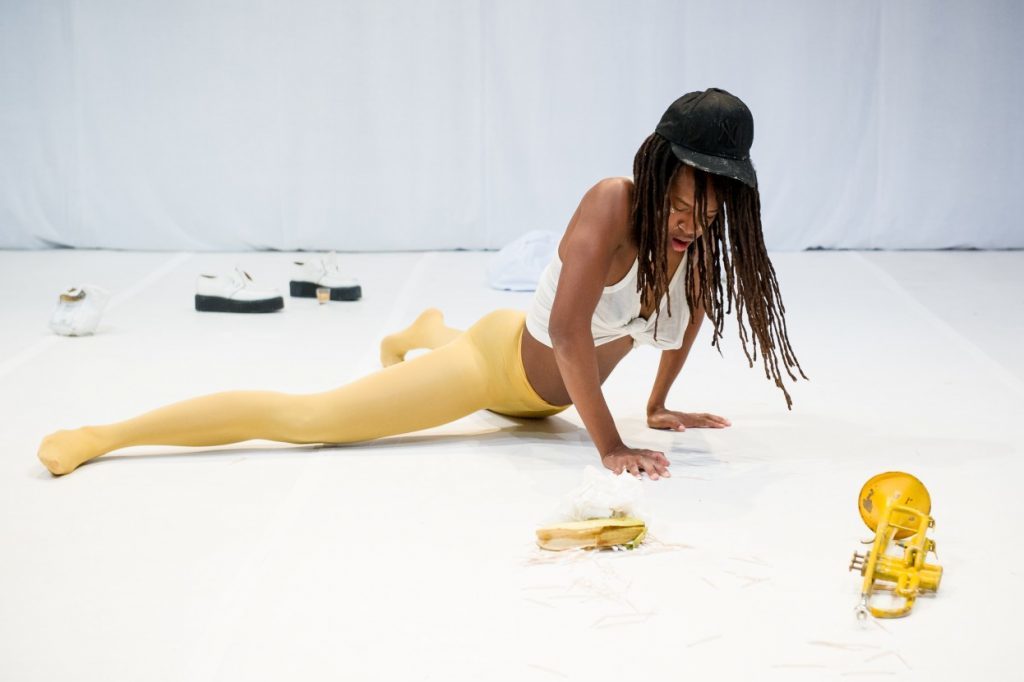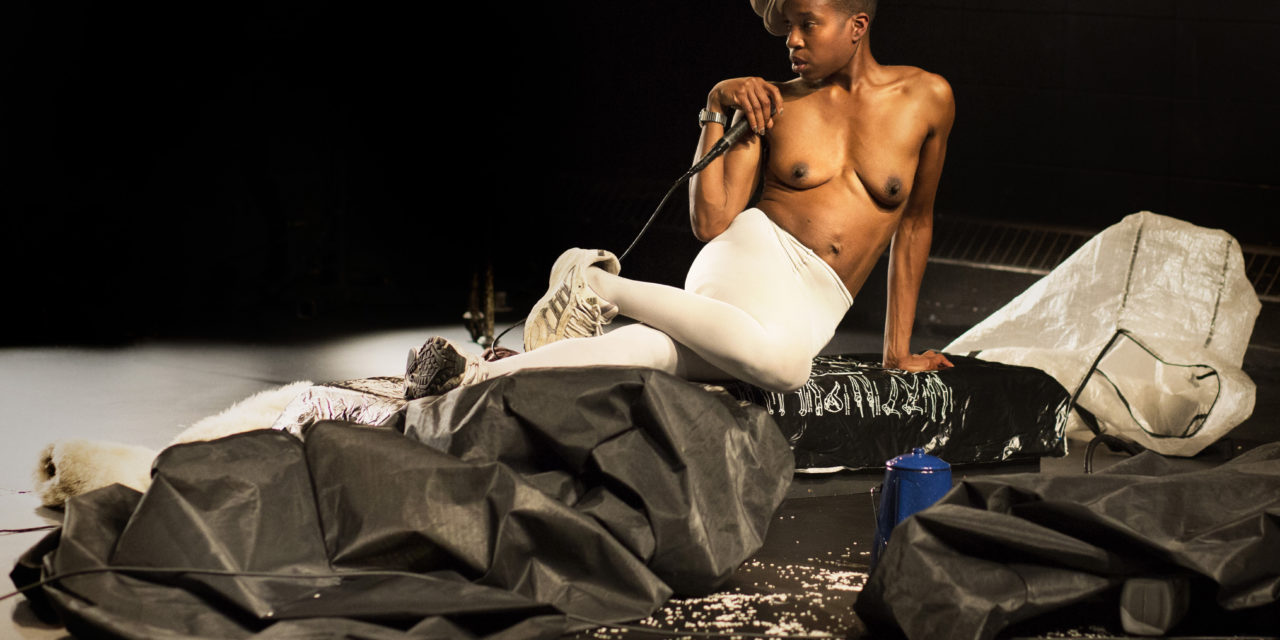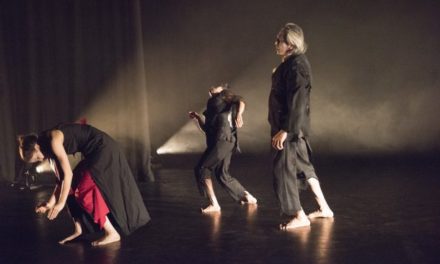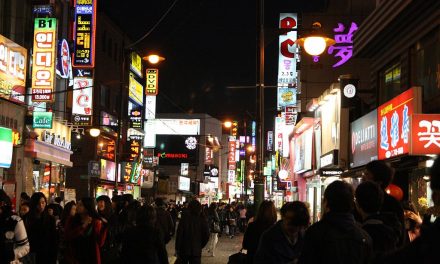Illegibility, Identity, Blackness
The lack of black choreographers/ black voices in Contemporary Dance has created a large gap in the understanding of blackness, allowing that label to be thrown at any choreographer who bears the racial marking of being black. In the solo work Mercurial George by the Montreal-based choreographer Dana Michel, she confronts this racial imposition heads on, creating an anarchist ecology of things where identity and blackness can emerge in this illegible yet affectively charged mode of experience.
Dana Michel is slowly revealed within the spotlight on stage left, her chest bare, her legs wrapped in white tights and sneakers, accentuating her visible and glistening black skin that is exposed in her upper body. She is on all fours crawling, sliding, and fidgeting among an array of objects pre-set in the theatre. She reaches for what-seems-to-be a metal kettle–but she does not exactly reach for it: she picks it up, puts it down, pushes it forward, moves it around before eventually bringing her body to sit on it. She proceeds to grab the large black bags in her vicinity (but not exactly grabbing them) and spends the next several minutes trying to fit herself in a bag in the same tortuous manner. Meanwhile, her body is caught in incessant spasms, as if her joints and muscles have independent minds that can twitch and jerk on their own demand, creating multiple roundabouts and detours to interrupt the visibly direct pathway between Michel and the objects.
When I was watching Mercurial George for the first time at the festival American Realness in New York City, my head was about to explode during these first prolonged moments: “Why can’t she just put herself in the freaking bag?” Whispered quietly with a sense of utmost frustration, I then let this question sink in, allowing myself to momentarily escape the work and start dwelling on my negative outburst. At that instance, something just clicks in me: if only identity were that simple – to just put oneself in a bag and voila! Nothing about identity is as straightforward as molding oneself into a container, nor especially blackness. It is important that she has to squeeze the bag with her whole body first before opening it up, to start crawling inside only to get distracted by the mic nearby, to murmur “no, no, no” while concurrently pushing the bag away and pulling it over herself. She has to wrestle with whatever is given to her, critically deconstructing the directness of any action that can be too easily taken for granted.
Stretching Out Identity In Time
Frankly, after this opening section in Mercurial George, I no longer feel compelled to put names onto Michel’s actions. My usual compulsion to pin down exactly what happens after what in the work, slowly dissolves away, giving room for a mode of affective experience that is not so intelligible but is no less rigorous. Michel’s work invites me to not know what it is that she is doing, to drift away from this frustration towards the indulgence of daydreaming and yet, to still be able to somehow burst out laughing a few minutes later when she pulls out a metal skewer poking at a bag of white powder, slapping it and splashing it all around the stage. There are no words to explain why it is that I am laughing, or what it is that I am laughing at, but it is undeniably funny. An ambiguous space emerges that holds together both illegibility and affective intensity, where I can giggle without knowing the joke, or cry without being told the sad story.
Time becomes an essential element that sustains this paradox of being overwhelmed by feeling and not knowing why. Michel’s stretching out of temporality generates a very intense affective quality that makes it too overwhelming to stay focused on her for every moment of the work. When Michel manages to finally make her way up to standing, albeit painfully slowly, there is an inexplicable yet dramatic shift in the room–a mixture of relief, of excitement, of perpetual boredom–as if we have all been waiting so long for this moment…and then we have to keep waiting.
She puts on a fur coat that seems too heavy for her frame, wraps a small cut-out of her portrait around her forehead, picks up the mic on one hand, and a horn, a bag of bread on the other. The whole stage is now lit up from the back, at some point a triumphant and trumpet-heavy piece of music is played in the background. For the next ten minutes or so, Michel rocks back and forth on her turn-out feet, letting the objects in her hands swing and sway along with the rhythm. Her head slightly dropped, her body always relaxed but also distorted, she would occasionally squeeze the horn or mumble something into the mic. Nothing much happens over this rather long period of time, and at once so many things are happening, so many feelings are being generated in this repetitive, and at times comedic slowness.
Her slowness does not appear as much of an intellectual critique towards the fast-paced mode of dance consumption, as an intimate and profound relationship with things that simply take longer to unfold. In other words, Michel does not try to make a statement or to disrupt the flow of Contemporary Dance with her slowness – she is not “exhausting dance” the way André Lepecki theorizes how a “slower ontology” can interrupt the kinetic project of modernity. Rather, slowness feels very personal; it has to be felt and not understood, to be absorbed and dissolved into the affective realm of experience. Only then can this chaotic mess emerge from that which has often been reduced and consolidated into this monolithic category of “identity,” troubling and undoing the legibility of blackness in order to open up for something more unstable and more visceral.
The questions that Michel asks during Mercurial George are quite direct yet not at all easy to answer, and any attempt to tackle them no doubt demands time. This dichotomy between finding identity and having an identity placed on oneself is never a clear either/or, but it is a tug-of-war, a push-and-pull so forceful that eventually the two polarities entangle into each other, bundle up into a cluttered pile of stuff hiding under the facade of a unified material body. To stretch out in time, then, is to destabilize Michel’s black female body, to let its corporeality dissolve into to the illegibility of the affective register, and to conjure up the violent storm that is being concealed within the illusionary category of “identity”.
“Mercurial George is born out of necessity, out of the urgency for Michel to steer the narrative on her own term: if her works has to be about blackness, at least it will be about her blackness.”
“Identity” becomes an even more intricate issue when it is specified and localized to blackness, an explosive racial marking especially within the predominantly white Euro-centric space of Contemporary Dance. In an interview with CBC, Michel openly addresses the imposition of blackness onto her works by the press that often falls beyond her control: “No matter what I did. Every piece that I did was ‘urban’ or ‘West African.’”2 When there are so few black voices in a field that is deeply rooted in whiteness, their racial marking immediately stands out as a category for their works, as an imprint of othering that limits them to the legible zone of “urbanity.” Lacking the historical framework to understand the intricacy of black dances, this mode of othering in Contemporary Dance bears the burden of slavery and racism, where there is a recurrence of whiteness trying to manufacture what blackness means and what a black body signifies (this process is made quite literal with blackface minstrelsy, specifically). Thus, as Michel inherits this prescriptive racial imposition that is not only exclusive to North America but has been exported into the global formation of races, it is never a choice to not work with blackness – Mercurial George is born out of necessity, out of the urgency for Michel to steer the narrative on her own term: if her works have to be about blackness, at least it will be about her blackness.
It might seem quite promising to make this distinction between “blackness” as an abstract imposition of racial identity and “her blackness” as a more intimate understanding of race. At the same time, this artificial separation does not exactly crack open the intricate and messy matrix of identity that explodes in the process of troubling of this dichotomy between construction and exploration. Even in her previous effort to reject this manufacture of blackness by not taking African dance classes,3 this prescriptive racial representation still comes back to haunt her and define her works as she attempts to escape from this unimaginative category. Hence, the choreographer is caught in a paradox where the external construction of blackness also fundamentally shapes her own process of self-exploration, trapping her within this in-between space that is deprived of any absolute resolution. It is no wonder that with her previous contemplation on blackness, Yellow Towel (2013), Michel spends a lot of time digging into the stereotypes of black community, working on and against the racialized implications of, for instance, hair and hoodie, using these fraudulent yet legible images of blackness as a springboard to wrestle with her own identity.

Yellow Towel Photo: Ian Douglas
In Mercurial George, the choreographer also deploys the stereotypical representation of the primitive black body as a grounding point, alluding in her title to Curious George, an African monkey character in a series of popular children books in the 20th century. This prevalent association between primate and “Africa,” between primitivity and blackness is uncannily visible in Michel’s performance, either with the infant-like language that often dwells on the incomprehensible repetition of words or with the jerky, uncontrollable bodily movements.
However, rather than giving whiteness more ammunition to trap black bodies in a primordial temporality and spatiality, the choreographer’s recycling of primitive signs has the ability to collapse this racialized demarcation from inside out. Turning primitivity on its head, Michel actively inhabits what Moten and Harney call “the crazy, nonsensical, ranting language of the other,”4 which is illegible to, and thus, abandoned by the governing force of colonialism and whiteness.
If we take Tina Post’s formulation on the construction of blackness as a process when a black body comes to stand for the black body,5 then Michel as a black body also has the agency to subvert the black body, to yank it out of its comfort zone of legibility. In a paradigm of whiteness where any efforts to read Michel’s dances become a reference to and/or a reification of the black body, troubling legibility surfaces as a viable scheme of experimentation that can both recycle and pervert this static racialized representation. The term “identity,” when extrapolated from this understanding of blackness, must be destabilized, perhaps gesturing towards a more elusive concept of “subjectivity”, and “black subjectivity” especially: identity is only useful insofar as it wrestles with a process of exploration that is always implicated by the force of identification and imposition.
Ecology of Things
The rows of backlights slowly dim to darkness. A melancholic synth-driven piece of music is being played in the background. Michel makes her way into the pop-up tent set up in stage center, inside which stands a podium where she delivers a rather strange lecture/song/chant: “Cream and milk and butter… And cream, cream, milk, milk… Shake, whip, shake them together.” The light starts strobing… She appears as if she is in a trance. Her eyes roll back to the skull, her bare chest constantly jolts in and out of sight, her arms extend in the air spinning a spatula around in a circle.
When the back lights come on again, Michel can be seen on the floor behind the tent, now with dreadlocks being slipped on her shaven head. She lies dead still for a moment before twitching, gradually dragging herself towards a wheeled table. As if the dreadlocks draping over her face are too heavy for her body, she leans against the table pushing it to the other side of the stage in a painfully difficult manner. After somewhat settling in place, she brings the flour and the dough on the table down underneath it, creating a little workstation on the floor and begins kneading the dough for the next several minutes.
As I pin down a series of events happening in Mercurial George, I find myself getting caught in the conundrum of making the performance legible for writing purposes while having to concurrently animate Michel’s intricate, strange, singular relationship with time, and especially with things. In fact, this linear mode of experiencing dance that is inherent in my description of the work becomes inherently corrupted by the thingliness of the objects on stage, where objects can take on lives of their own instead of being submitted to the human need for utility. The myriad of things that initially inhabit the zone of objecthood, recognizable with distinct names such as tent, podium, spatula, dough, all of which are dislocated and perverted through the prolonged interplay with Michel’s body and with each other.
As utility becomes secondary, shapes, materials, elasticity, and vitality begins to unfold, prompting an enigmatic revelation of a poetic space where the interwoven relations between things-things, human-things can be particularly felt. This process of inter-animation enables a mutual contamination where matters spill into each other, collapsing the rigid contours of materiality to allow the ambiguity of effects to permeate. Visual legibility with its hegemony as a sensual mode of experience gradually diminishes in this relational ecology, relinquishing to a means of transmission that is less authoritarian in its unbound interpersonal vibration.
Here, things are not used by the choreographer to express her identity per se, but they are highly animated beings, appearing as houses of identity just as much as her body does. The human has been stripped of its privileged signification: Michel is given a sense of subjecthood only insofar as she plugs herself in the ecology of things and becomes a thing herself. Michel’s strategy of turning (in)to things deflects the visible signification of her black body, opening up a more fugitive space tugged away from the imposition of identity to explore a black subjectivity that is illegible yet can be intensely felt.
In this effectively charged ecology, an awareness of blackness materializes and simultaneously dissipates into its opacity. Especially when compared to Yellow Towel in which there are much fewer things being explored, Mercurial George’s messiness pushes the black self to the edge of ambiguity and ephemerality. The moment identity feels somewhat settled and consolidated within a particular thingly relation, it is immediately uprooted when another exchange gains traction and disrupts the established, albeit fleeting, status quo. Thus, blackness reverberates and ricochets endlessly in between one thing and another, with each reverberation piercing through the imposition of blackness in Contemporary Dance. A strange, obscure and singular blackness can emerge without bearing resemblances to the blackness, generating an anarchic space where subjectivity can be renegotiated, reimagined and reinvented.
Michel clearly does not set the audience up for an easily digestible experience, a one-size-fits-all mold of identity and blackness that can be served on a platter to the spectators, or perhaps even to herself. The very fact that the choreographer frames Mercurial George as an extension to her previous work Yellow Towel already reveals the muddled and messy space that she is getting into, that she is continuously digging and excavating even after years of constant researching and touring. Perhaps, the word “dig” is emblematic of the whole process behind Michel’s formulation of identity and blackness: to go deeper, and deeper, and deeper. To dig is not to find things, to get somewhere but the verb bears the weight of a responsibility, a devotion to keep pushing further into the unknown. To dig is to inevitably press oneself to the edge of illegibility, to awake the unfamiliar being which has never been touched, and most importantly, felt.
1 http://americanrealness.com/portfolio-type/dana-michel-4/
3 Ibid.
4 Harney, Stephen Matthias, and Fred Moten. The Undercommons: Fugitive Planning And Black Study. (2013).
5 Post, Tina. Williams, Walker, And Shine: Blackbody Blackface, Or The Importance Of Being Surface. TDR/The Drama Review 59, no. 4 (2015), 97.
This post originally appeared on Etcetera on October 25, 2017, and has been reposted with permission.
This post was written by the author in their personal capacity.The opinions expressed in this article are the author’s own and do not reflect the view of The Theatre Times, their staff or collaborators.
This post was written by Anh Vo.
The views expressed here belong to the author and do not necessarily reflect our views and opinions.


















